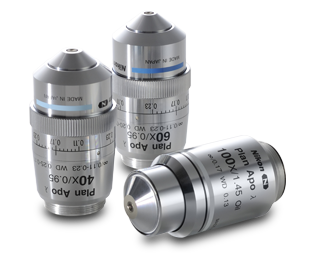Microscope objectives are typically classified as being brighter or darker based on NA, or  Numerical Aperture. This is for good reason, as the NA of a lens will affect both the amount of light delivered to a specimen (excitation) and the amount of light collected from a specimen (emission). In addition to this, NA increases in both the X and Y axes, so a 0.1NA increase increases the efficiency of an objective by 0.1², which translates into a LOT more light. But how does magnification affect the brightness of a lens?
Numerical Aperture. This is for good reason, as the NA of a lens will affect both the amount of light delivered to a specimen (excitation) and the amount of light collected from a specimen (emission). In addition to this, NA increases in both the X and Y axes, so a 0.1NA increase increases the efficiency of an objective by 0.1², which translates into a LOT more light. But how does magnification affect the brightness of a lens?
Consider a typical set of high magnification oil immersion lenses, let’s look at a 100x 1.4NA, and a 60x 1.4NA. If the NA is the same, we can determine that:
- the minimum resolvable distance is the same (affected by NA)
- the excitation.emission efficiency is the same (affected by NA)
So how will the magnification affect the overall brightness? If the NA of the lens specifies the accuracy we can resolve at the specimen plane, then the magnification of the objective relays that resolvable distance, to either a detector (camera) or our eye. If the magnification is low, the amount of information, or light, per unit area, will be greater, at a lower magnification. Kurt Thorne has a good example of this on his post regarding space bandwidth product, which shows just how much more information is packed into a 60x lens due to the larger FOV. So – if we have the same light collecting ability at 60x, as we have at 100x, then we have concentrated the same amount of light onto a smaller point at our camera, or at our eye.
What this leads to is that we have a choice of which resolution we want to maximize, if we want to obtain the most dynamic range, or the fastest capture frequency, or a large field of view, (or any combination thereof) we would choose the 60x lens. The 60x grabs a larger field of view, and packs the most light into the image sent to our oculars or camera.
On the other hand, if we want the absolute highest spatial resolution, say for a large-pixel EMCCD, then we could choose the 100x, to spread our light over a greater # of pixels.
It’s not uncommon for microscopes to be equipped with only one high magnification oil immersion lens, and usually it’ll be either the 60x or the 100x. So, if you are considering which lens to buy, or to standardize on for your research, consider the importance of both magnification AND field of view/brightness. You may find that a lower mag objective improves the quality of your data!
-Austin
Comments
2 responses to “NA vs. magnification, or why a 60x objective is brighter than a 100x”
On the other hand NA and magnification are not related, so if you decided to skip the tube lens and use your own you could design independently the resolving power (NA, via the objective) and the magnified area (via the tube lens).
Some systems provide for multiple tube lens positions (Zeiss inverts usually have this as well as the Nikon Ti-E series). This is nice both because of your point related to magnification vs. NA, but also nice as you can operate with a wide range of sensor sizes without needing sensor-side adapters, which soak up more light.